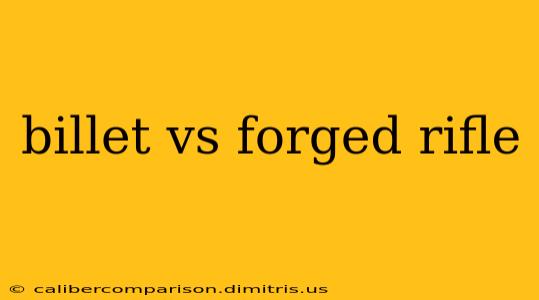Choosing a rifle involves many considerations, but the receiver—the heart of the firearm—often gets overlooked. Two primary manufacturing processes dominate receiver production: billet and forged. Understanding the differences between billet and forged rifle receivers is crucial for discerning shooters seeking optimal performance, durability, and value. This comprehensive guide delves into the intricacies of each process, highlighting their advantages and disadvantages to help you make an informed decision.
Understanding Billet Rifle Receivers
Billet receivers are machined from a solid block of aluminum or steel—a "billet"—using Computer Numerical Control (CNC) machining. This subtractive manufacturing process precisely removes material to create the receiver's intricate features.
Advantages of Billet Receivers:
- Exceptional Accuracy: The CNC machining process allows for extremely tight tolerances, resulting in superior dimensional accuracy and consistent receiver specifications. This contributes to improved accuracy and reliability.
- Design Flexibility: Billet machining offers immense design flexibility. Manufacturers can create complex geometries and custom features not easily achievable with forging. This is especially appealing for specialized or custom builds.
- Potential for Lightweight Designs: By carefully removing material, billet receivers can be crafted to be relatively lightweight without sacrificing strength in key areas.
- High Strength-to-Weight Ratio (in some cases): Depending on the billet material and machining techniques, billet receivers can boast a favorable strength-to-weight ratio, particularly when using high-strength aluminum alloys.
Disadvantages of Billet Receivers:
- Higher Cost: The CNC machining process is time-consuming and requires specialized equipment, resulting in higher production costs compared to forging.
- Material Waste: A significant amount of material is removed during machining, leading to waste and higher material costs.
- Potential for Stress Concentrations: Improper machining can create stress concentrations in the receiver, potentially compromising its structural integrity. This is mitigated by experienced manufacturers and rigorous quality control.
Understanding Forged Rifle Receivers
Forged receivers are created by shaping a heated metal blank (typically steel or aluminum) using a die under high pressure. This forms the receiver's basic shape, which is then further refined through machining.
Advantages of Forged Receivers:
- Lower Cost: Forging is a more efficient and less material-intensive process than machining, resulting in lower production costs.
- Superior Strength and Durability: The forging process aligns the metal grain structure, resulting in a receiver with superior strength and impact resistance compared to billet receivers.
- Less Material Waste: Forging utilizes significantly less raw material compared to billet machining.
- Established Manufacturing Process: Forging is a well-established manufacturing technique with robust quality control measures.
Disadvantages of Forged Receivers:
- Less Design Flexibility: Forging is less flexible in terms of design complexity. Intricate or highly customized features are more challenging and potentially more costly to achieve.
- Potential for Inclusions: While modern forging processes minimize this, there’s a slightly higher chance of microscopic inclusions within the metal, potentially impacting long-term durability. Reputable manufacturers use rigorous inspection to minimize this risk.
- Machining Still Required: While forging creates the basic shape, significant machining is still required to finish the receiver, including drilling, milling, and threading.
Billet vs. Forged: Which is Right for You?
The "best" choice depends heavily on your priorities and budget.
-
Choose a billet receiver if: You require maximum design flexibility, prioritize tight tolerances and exceptional accuracy, and are willing to pay a premium for a potentially lighter receiver. Precision and customizability are paramount.
-
Choose a forged receiver if: You prioritize strength, durability, and value for money. You need a robust receiver that can withstand harsh conditions and heavy use.
Ultimately, both billet and forged receivers can produce high-quality firearms. The critical factor is choosing a reputable manufacturer that employs rigorous quality control measures regardless of the manufacturing process used. Research the manufacturer's reputation and read reviews before making your purchase.

